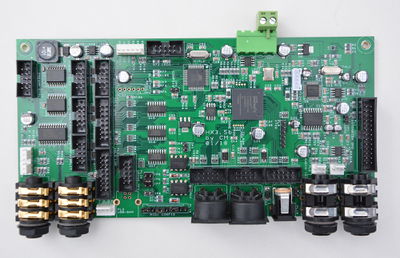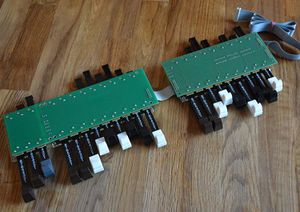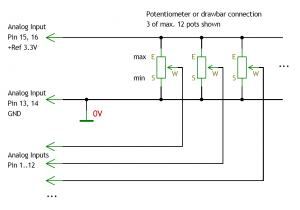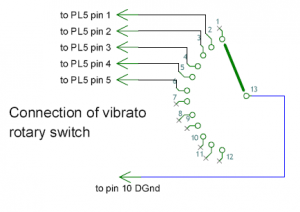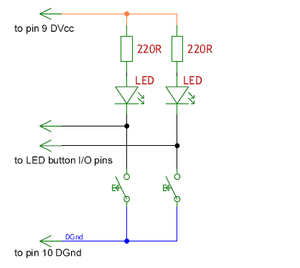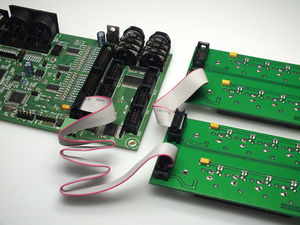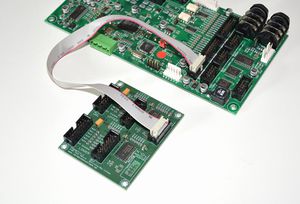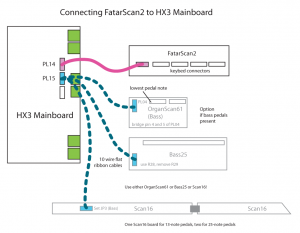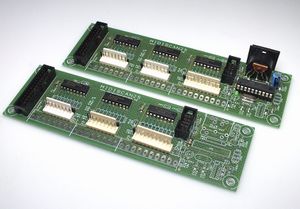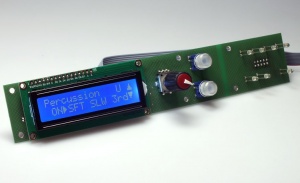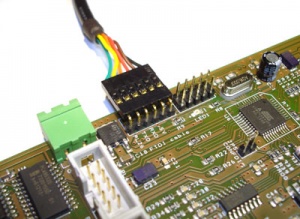HX3.5 Installation Manual
June 26th, 2018
HX3.5 single-board sound engine for connecting any keyboard, for installation into existing organs or MIDI control
Preface
HX3.5 should be installed by a qualified technician only. You should be familiar with ribbon cable mounting, crimp contact installation and soldering of delicate parts. Important: Boards contains static sensitive components. Be sure to use anti-static tools and grounded soldering toolset.
Power Supply
The board may be powered either from coaxial DC input PL10 (5.5/2.1 mm plug, DC 9V 500mA wall wart) or from green DC connectors PL12 (9 to 12V input) or PL11 (5V input; 5V output when power provided to DC jack PL10 or PL12). Voltages exceeding 5.2V on PL11 will destroy the board!
After powering on, a red LED near PL17 will flicker briefly; it will also flicker when the HX3.5 controller is busy. When the RealOrgan Sound Engine is ready, a yellow LED will dim; it will "breathe" with rotary simulation speed. When the Effects/GM DSP is ready, a blue LED will flash every second. The blue LED will blink when the DSP is ready to accept a DFU firmware update by USB.
Updating Firmware
A new controller firmware and FPGA image (Sound Engine) may be installed using a standard SD or SDHC card. For this purpose, an SD card adapter is provided with every board. Attach SD card adaptor cable to PL17.
An update will start automatically on power-on when a file called "autorun.ini" is present on SD card. Once the update is completed, this file will be renamed to "_autorun.ini" to prevent further obsolete updates. The update may be started manually by menu as well. A list of available update options (INI scripts) are displayed; select by MenuPanel encoder knob. A script is started by pressing the encoder knob for about 2 seconds.
As of today, the effects/GM DSP (firmware, GM sound banks) may be updated through USB only.
Firmware images are made available through our Github repository.
Use as MIDI Expander
The HX3.5 board is configured as a simple MIDI Expander from factory. Do not connect any peripherals to black ribbon cable connectors except a MenuPanel to PL21.
Connecting Analog Inputs
HX3 provides 24 analog inputs, all located on pin headers PL9 and PL13. All analog inputs are DC controlled. Input voltage range is from 0V (off or minimal volume) to +3.3V (max. volume). HX3 may also be used without any switches/drawbars/pots connected by installing the MIDI Expander firmware. You may leave all internal connectors open if you plan to remote by MIDI only with analog control inputs disabled. Note: One analog input is internally tied to SWELL jack and should remain open.
Connecting Drawbar 9/11/12 Boards
Connection to our drawbar boards Drawbar9 and Drawbar12 is very simple: Drawbar9 (upper) connects to PL9, Drawbar12 (lower) connects to PL13 via 16-wire flat ribbon cable (length up to 1m, plugs wired 1:1). Drawbar9 provides 3-pin headers for connection of Tone and Amp122 Volume pots; may be disabled by HX3 Remote parameter 481 if adusted by MenuPanel. Additional Drawbar9-MPX boards may be inserted for "two drawbar sets per manual" configurations. Note that Drawbar9-MPX must be the right drawbar set for each manual as on Hammond Consoles (see picture).
Drawbar9 and Drawbar11/12 are compatible and interchangeable, despite additional drawbars for bass pedals resp. tone/amp volume.
Note to HX3 mk2/mk3 users: Older HX3 boards do not provide a drawbar set switching signal for Drawbar 9-MPX on Pin 15 of PL9 and PL13. From firmware #3.925 and up, switching signals are provided on vibrato knob port PL5 (otherwise unused) pin 6 (upper manual drawbars) and pin 7 (lower). You have to route two single wires from these pins to each PL43 of Drawbar9-MPX (middle pin).
Connecting other Drawbar Pots
You may also use your own or existing drawbars as follows: At least connect 9 drawbars or slider pots and Leslie volume control pot to PL22 ANLG UPPER. R value should be in the 10 kOhm to 47 kOhm range, linear taper (for example type B10K). Note that using audio taper (log.) drawbar pots as found in various older LSI and transistor organs will not yield correct loudness and drawbar position on MenuPanel display.
PL22 ANLG UPPER (Control Voltages Upper Manual)
Pin - function
1: Drawbar 16
2: Drawbar 5 1/3
3: Drawbar 8
4: Drawbar 4
5: Drawbar 2 2/3
6: Drawbar 2
7: Drawbar 1 5/9
8: Drawbar 1 1/3
9: Drawbar 1
10: Aux/Tone Pot
11: Amp Pot, simulated rotary tube amp volume
12: Auxiliary Pot
13, 14: Drawbar/Pot common Ground GND
15: Drawbar set A/B switch signal (may be tied to pin 16)
16: Drawbar/Pot End 3.3V+ (Reference)
PL23 ANLG LWR (Control Voltages Lower Manual)
Pin - function
1: Drawbar 16
2: Drawbar 5 1/3
3: Drawbar 8
4: Drawbar 4
5: Drawbar 2 2/3
6: Drawbar 2
7: Drawbar 1 5/9
8: Drawbar 1 1/3
9: Drawbar 1
10: Drawbar Bass 16
11: Drawbar Bass 8
12: Drawbar/Pot Bass Sustain
13, 14: Drawbar/Pot common Ground GND
15: Drawbar set A/B switch signal (may be tied to pin 16)
16: Drawbar/Pot End 3.3V+ (Reference)
Even with MIDI control, a swell pedal should be connected to SWELL jack for faster response. This overrides MIDI volume control. You may connect a swell pedal like Yamaha FC-7 or a simple volume pot to the SWELL jack.
HX3 mainboard is set to tone/treble and amp volume control inputs active by factory (may be altered also with HX3 Editor). Tone pot center is connected to pin 10 of PL22. Pin 11 becomes the Leslie amp volume/drive control (mandatory). Amp volume pot center is connected to pin 11 of PL22. Both pots begin with GND and end with Ref 3.3V+.
Please note: Open analog inputs (unconnected) will "float" and change randomly, even with presets active. Tie unused inputs to ground or fixed level (ie. trimpot).
Connecting Digital Inputs
HX3.5 provides 16 digital inputs plus one rotary swich input. Switches are defined as tab stops, rocker or toggle switches, buttons are momentary switch contacts, normally open. All inputs are active low, i.e. tie to ground when switch/button is operated.
Panel16
Easiest solution for a register/stop panel is using our Panel16 board connected to PL7 and PL11 by two 10-wire flat ribbon cables. Panel 16 provides 16 buttons for complete HX3 control; just add the rotary switch for vibrato depth.
Panel16 has 4 "Common Preset" buttons, common to upper and lower manual. They may be used as buttons selecting V1-V3 vibrato or C1-C3 Chorus depth by updating your HX3 to "Button Vibrato" (_btnvib) firmware. In this case, omit the vibrato rotary switch.
Other Buttons or Switches
Instead of Panel 16 you may also connect your own buttons or tab switches (up to 16). Every function is activated by either a button on digital inputs PL7/PL11 or a switch on PL8/PL12 (mk2 only). A momentary contact to ground on each PL7/PL11 pin will toggle it's status and drive indicator LEDs (see schematic). Leave unused digital inputs open.
To use tab stop switches on mk3/mk4 boards, define P22 and PL23 inputs as switches by HX3 Editor Application, "System Inits" parameter page. Check boxes in "ButtonMask" parameter row 1499 and 1500 to define an input pin as a switch instead of a button. The rightmost check box represents Pin 1 and so forth, up to leftmost box for pin 8. When using buttons, an indicator LED should be installed as shown; otherwise there is no indication if a tab stop is on or off.
Vibrato/chorus V1 to C3 is selected by a rotary switch:
Pinout PL21 VIBSW Vibrato rotary switch
Pin - function (active low – switch to Gnd)
nc: Vib1 (no connection)
1: Cho1
2: Vib2
3: Cho2
4: Vib3
5: Cho3
6: not used
7: not used
8: not used
9: not used
10: Common Gnd
Factory Pinout PL22 buttons (momentary contact, optional LED)
Pin - function (active low – switch to Gnd)
1: Perc ON, like B3
2: Perc SOFT
3: Perc FAST
4: Perc THIRD
5: Vib ON upper
6: Vib ON lower
7: Leslie ON (connected LED blinks with Leslie speed)
8: Leslie FAST
9: (+5V, used only for button LEDs supply, e.g. on Panel16)
10: Common Gnd
Factory Pinout PL23 buttons (momentary contact, optional LED)
Pin - function (active low – switch to Gnd)
1: Common Preset 1 (only button on PL11 - do not use pin 1 of PL12!)
2: Common Preset 2 (only button on PL11 - do not use pin 2 of PL12!)
3: Common Preset 3 (only button on PL11 - do not use pin 3 of PL12!)
4: Common Preset 4 (only button on PL11 - do not use pin 4 of PL12!)
5: EFX 1 / Reverb 1
6: EFX 2 / Reverb 2
7: Bass on Leslie (routes pedal bass also to Leslie simulation if ON)
8: Split ON
9: (+5V, used only for button LEDs supply, e.g. on Panel16)
10: Common Gnd
Connecting Presets
HX3.5 board does provide 4 "common" presets (see Pinout PL23) for both upper and lower manual. It may be extended to 2x8, 2x12 or 2x16 presets with optional boards Preset12-2 or Preset16 (one or two). All connect to HX3 PL21 by 10-wire flat ribbon cable. HX3 PL21 is a I2C bus system, so all boards connect in parallel (use multiple 10-pin plugs on one cable if necessary); Preset12 and Preset16 provide an extension route-through connector for adding more boards. Cable length on HX3 PL21 should not exceed 100 cm (40") in total. Use appropriate firmware for each preset solution. See description of each product for details. Obsolete boards are still supported by newer firmware issues.
Preset16
Preset 16 is a self-contained panel with 2 rows of 8 LED buttons each. It connects to HX3 PL21 by a 10-wire flat ribbon cable. A second Preset 16 may be connected to second 10-pin header (daisy-chain). Both 10-pin headers on Preset16 may be used (are wired in parallel). A jumper set on Preset16 selects upper manual. If jumper is absent, Preset16 works on lower manual.
If only one Preset16 is connected, jumper JP1 must be set on preset board. Now upper row of buttons is for upper manual, lower row for lower manual (i.e. 8 presets each). This preset split function may be overridden by param 1505 in HX3 Editor set to ON.
If using 2 sets of drawbars per manual by DB9-MPX drawbar board board, set HX3 Editor "System Inits" parameter 1496 "2nd Drawbar Select Voice Number" to 1. This will activate 1st drawbar set on Preset 0, 2nd drawbar set on Preset 1.
Preset12-2
Preset12-2 is an interface board for up to 2 x 12 "inverted" preset keys (with optional LED indicators) as found on Hammond console organs. Preset16 PCB is similar to Panel16, but has additional circuitry and connects to HX3.5 PL21 by a 10-wire flat ribbon cable. See schematics for pin designation. Pin 1 of both 14-pin headers is Preset 0 = Live (right drawbar set) = B key, pin 2 is Preset 1 = Live (left drawbar set) etc. downto pin 12 = CANCEL key.
Standard organ firmware supports momentary contacts. To save a preset, press and hold preset key/button for 2 seconds.
If using 2 sets of drawbars per manual by DB9-MPX drawbars/multiplexer and Preset12-2 board, set HX3 Editor "System Inits" parameter 1496 "2nd Drawbar Select Voice Number" to 1.
Pinout PL1 (LEDs)
Pin - function
1: LED 1 cathode (Preset 0, "B" key drawbar set)
2: LED 2 cathode (Preset 1, "A#" key drawbar set)
3: LED 3 cathode (Preset 2)
...
12: LED 12 cathode (Preset 11, CANCEL key)
13,14: Common LED anode (+)
LED outputs have on-board 220 Ohms resistors, resulting in 15 mA LED current. Long leg of LEDs is anode (+), short leg is cathode (-).
Pinout PL2 (Buttons/Switches)
Pin - function (active low – switch to Gnd)
1: Switch 1 (Preset 0, "B" key drawbar set)
2: Switch 2 (Preset 1, "A#" key drawbar set)
3: Switch 3 (Preset 2)
...
12: Switch 12 (Preset 11, CANCEL key)
13,14: Common switch ground (0V)
Connecting Keyboard Scan Board(s)
For lowest key-to-audio latency we recommend direct keyboard connection via scan board (different versions available). Use scan driver installation INI script on SD card (scanmidi.ini for MIDI only, scanfatr,ini for FatarScan2 scan board) to update appropriate scan driver.
Scan Cores will support MIDI input/output too, but for pure MIDI remote we recommend MIDI input driver.
FatarScan2
A single FatarScan2 board is connected to HX3.5 PL9 FATAR SCAN. One or two Fatar 61 key manuals (type TP/8O or similar) may be connected to one FatarScan2 board using a special cable set (MicroMatch connectors to keyboard scanning strips). See page Anschluss der Scan-Platine FatarScan2 (german) for more pictures. We recommend buying the FatarScan2 cable set for connection to MicroMatch headers on Fatar keybeds (one set for each manual).
A FatarScan2 board must be connected to PL9, otherwise loud noise will be heard.
Bass pedals may be connected to an additional Scan16-Strip, Scan61-Inline or Bass25 board wired to HX3 PL15 (!).
Bass25
Bass25 scan board (refer to PDFs in our Github repo folder PLATNEN/BASS25) may be used as an addition to FatarScan2, OrganScan61, Scan61-Inline and Scan16-Strip boards for convenient connection of bass pedal contacts as pictured above (note different HX3 headers). Board may be placed in bottom of organ if 10-wire flat ribbon cable to HX3 or last OrganScan61 board does not exceed 1m. Please note jumper setting on Bass25:
- JP1 solder bridge, always open
- JP2 solder bridge if used with OrganScan61 (daisy chain on HX3 PL14), Bass25 to last OrganScan61 board
- JP3 solder bridge if used with FatarScan2 on HX3 PL14 or Scan16 Strip on HX3 PL15
Bass25 provides in-line headers and a 26-pin flat ribbon cable connector for alternative connection of bass pedal contacts:
Pin - function (active low – switch to Gnd)
1: Lowest note "C"
...
25: Highest note "C"
26: Common ground (busbar)
JP3 and JP4 solder bridges must be closed. 2-pin inline header PL9 also provides common ground for the busbar.
Note: A third Scan16-Strip or Scan61-Inline board may alternatively be used for bass pedal instead of Bass25, using only the first 13 or 25 contact inputs. Set jumper JP3 on scan boards to enable them for bass pedal use.
Bass25 MIDI
Bass25 MIDI is equipped with an own MIDI controller and MIDI output jack. It is connected to HX3 mk3/mk4 main board by 5-wire MIDI cable. Bass25 MIDI provides in-line headers and a 26-pin flat ribbon cable connector for alternative connection of bass pedal contacts. 2-pin inline header PL9 also provides common ground for the busbar.
Pin - function (active low – switch to Gnd)
1: Lowest note "C"
...
25: Highest note "C"
26: Common ground (busbar)
JP3 solder bridge must be closed.
JP4 solder bridge must be closed if Bass25 MIDI is powered by phantom supply from HX3 board, left MIDI input jack (seen from back). MIDI phantom power jumpers on HX3 board must be inserted (mk3 and mk4 boards only).
For separate power supply (internal +5V or external 9V DC wall wart), open JP4 solder bridge. Use 2-pin header PL12 next to MIDI OUT jack to supply internal +5V: Pin 1 (left, facing towards diode) is VCC +5V, pin 2 (right) is ground (refer to PDF schematics in our Github repo folder PLATNEN/BASS25).
A +5V MIDI phantom supply on outer pins of MIDI input may be obtained from HX3 mainboard by inserting two additional jumpers on HX3 PL10 pins 7-8 and 9-10. Do not install these jumpers if connecting other MIDI gear not using a phantom supply.
MenuPanel
Our MenuPanel allows convenient adjustments of various HX3 parameters to tweak your setup. Two versions available, short one without indicator LEDs intended for organ installation.
Connect HX3 MenuPanel to PL21 PANEL using a 10-wire flat ribbon cable. HX3 MenuPanel may be used in parallel/simultaneously with Preset12-2 and Preset16 boards connected to PL21 PANEL.
Extend a flat ribbon with additional connector to your cable on PL21 PANEL or use unoccupied 10-pin header on (last) Preset16 board which also carries the PL21 signal. PL21 carries an I2C bus system where all devices are wired in parallel.
See page HX3 MenuPanel for usage instructions.
Serial USB cable
For board configuration you need a serial connection through FTDI USB adaptor cable or USB interface. See page HX3.5 Editor for details.
